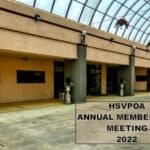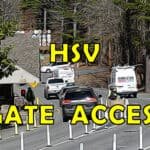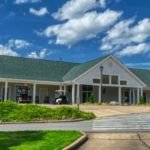Gene Garner vs. Hot Springs Village Board of Directors – Hot Springs Village Property Owners and Hot Springs Village Property Owners Association 63CV-19-116
By Cheryl Dowden, January 13, 2020
I have attempted to explain the hearing to the best of my ability. I am not an attorney, and I am certainly not a trained court reporter with a fancy transcription machine. This endeavor is an effort to provide a broad view of what transpired in the courthouse. While I tried to accurately portray the case, there may be slight errors in my reporting. For instance, in my notes I wrote “amend”, but I think in some instances it was actually stated as “revoke and create new”, as that makes more sense so that is what I reported. The words, “amend”, “rescind”, “add to” and “revoke” and “create” were stated many times by both attorneys and it was difficult to keep up.
On January 28, 2019, Gene Garner filed suit against Hot Springs Village Property Owners and Hot Springs Village Property Owners Association.
This case came to be heard in Saline County Court, Division III under Judge Grisham Phillips at a few minutes past 9:00 a.m. on January 10, 2020. This is close to a full year after the original complaint was filed. The courtroom temperatures were frigid on an overcast day in Benton, Arkansas.
Present in the courtroom were :
HSVPOA Board Vice-chair, Tormey Campagna; HSVPOA Director, Buddy Dixon, HSVPOA CEO, Lesley Nalley. Six Villagers also attended as courtroom observers including this reporter. No other press was present.
Judge Philips asked for the parties to identify themselves. Plaintiff Gene Garner was represented by Philip Montgomery of Legacy Law Group. HSVPOA Board Director Cindi Erickson was represented by E. B. (Chip) Chiles IV of Quattlebaum, Grooms and Tull.
- In this case, both sides agreed that HSVPOA BOD has the authority to amend, rescind and add to the original Protective Covenants. The difference of opinion is whether the original Protective Covenants were revoked and if the new Protective Covenants are a creation of a new document that replaces the old Protective Covenants. The Plaintiff (Garner) argued this is what happened. Also, the Plaintiff argued that the new Protective Covenants contain a fair amount of City Code. The Defendant (HSVPOA) argues the BOD merely amended and added to the original Protective Covenants.
- Secondarily, the Plaintiff argued that the BOD should have filed the new Protective Covenants with the court. The Defendant said this was not a requirement.
Judge Philips declared possible conflict of interest
Judge Phillips stated, “I am a nominal member of the Property Owners Association. I am not sure exactly how it works.” Judge Phillips has a friend who sold him a membership so he may play golf at Property Owner rates. Furthermore, the judge went on to say, “I don’t think I have a conflict of interest.”
Both parties agreed that they were comfortable proceeding in Judge Phillips courtroom.
Defense Attorney Chiles presented arguments
- The Plaintiff’s lawsuit sought a declaratory judgment that the Protective Covenants passed by the HSV Board are void. Attorney Chiles stated that Mr. Garner’s arguments are incorrect as a matter of law and a judgment should be issued in favor of the Defendants (HSVPOA BOD and HSVPOA).
- Property Owners in the Village are subject to Protective Covenants.
- Attorney Chiles stated the date of the original Protective Covenants was April 20, 1970. The Protective Covenants in question are dated April 2018.
- Over the years, the Protective Covenants have been amended and modified.
- Attorney Chiles also stated repeatedly that the POA BOD has the authority to amend, rescind or add to the original Protective Covenants.
- In April 2011, Cooper Communities, Incorporated entered an agreement of Assignment and Assumption of Developer rights with the POA. At this time, Cooper assigned these rights to the POA. These rights include the authority of the POABOD to amend, rescind or add to the original Protective Covenants.
- In May of 2014, the POA filed an amendment to the Protective Covenants of which the purpose was to transfer to the POA powers and obligations held by Cooper to amend, rescind or add to the Protective Covenants.
- Garner sued the POA in October 2014 (In this case Mr. Garner challenged the legitimacy of the two-tier assessments.) The Circuit Court of Garland County ruled In favor of the POA. The Arkansas Appeals Court affirmed this ruling.
- In Mr. Garner’s pleading for the latest case, he stated that the POA does not have the authority to revoke and create new Protective Covenants. The POA does not feel this is what happened and that they only amended and added to the old Protective Covenants.
- The POA was assigned these rights by Cooper.
- Article 14, Section 4 gave Cooper the authority to assign its rights.
- Paragraph 3 of the Protective Covenants say that the Protective Covenants may be amended by the Board.
- Mr. Garner is again suing after the Board amended the Protective Covenants in 2018.
- According to Attorney Chiles, Mr. Garner’s arguments this time are:
- The action by the POA in April 2018 revoked the previous Protective Covenants and this makes the 2018 Protective Covenants invalid since this was not approved by all owners.
- Mr. Garner questioned whether the Board has the authority to impose new restrictions and burdens on owners without owner approval.
- Even if not revoked, Mr. Garner questioned the Board’s authority to create a new set of restrictions that were “not contemplated by the Developer”.
- Attorney Chiles said the nature of Mr. Garner’s argument is that Board/POA overreached their authority.
- Attorney Chiles argued that this is wrong for several reasons.
- The Arkansas Court of Appeals stated in Mr. Garner’s previous suit the Board has the authority to amend, rescind and add to the Protective Covenants.
- Cooper showed it’s intent by originally reserving the right to amend, rescind and add to the Protective Covenants. Cooper specifically assigned these rights to the POA in 2011.
- The Protective Covenants were not revoked. They were amended and added to. Even if you believe they were revoked, “revoked” means rescinded.
- The code that Mr. Garner cites that says signatures of owners is required does not apply. That code only applies when restrictive covenants are created. HSVPOA Protective Covenants were already in place and were not “created” in 2018.
- Official recording at the courthouse was also not required. The Declaration and the Protective Covenants do not state that recording is required.
- There is a public filing which states that the Protective Covenants are located in the POA Administrative office and on Explore the Village dot com website. No further “notice” is required.
- Mr. Garner is not complaining about a specific act against him such as a fine. He is saying the BOD did not have the authority to revoke the old Protective Covenants and create new Protective Covenants.
Judge Phillips inquired as to what the changes in 2018 entailed
Attorney Chiles said the changes “flushed out details”. The original Protective Covenants was a three-page document. The 2018 Protective Covenants gave greater detail into what the general requirements were. A lot of these were already practices followed by the POA.
Mr. Garner said the new Protective Covenants were a code. Attorney Chiles said, “I am not sure I agree with that.”
Was there anything new in this case?
Judge Phillips asked about Attorney Chiles’s argument that there was nothing new in the case than what was previously decided in the past lawsuit.
Attorney Chiles said the specific amendments were different. Mr. Garner “challenges the authority of the Board”. The governing documents do not limit the Board’s authority to amend, rescind or add to the Protective Covenants.
Plaintiff Attorney Montgomery presented arguments
- Attorney Montgomery clarified what was amended. The original Protective Covenants were three pages. The new Protective Covenants are now over 100 pages. Every page of the new Protective Covenants has restrictions that were not in the original document.
- In the past Garner case, “the only issue before the court was” overlay zones. Overlay zones are restriction-free zones that the Board created.
- The Protective Covenants say that “all Protective Covenants are enforceable with the exception of areas designated as an overlay zone”. “Overlay zones outlines specific requirements for a clearly defined area. These requirements may vary among different overlay zones depending on the specific objectives of the area.” (32 of Protective Covenants)
- In the Court’s order, the Judge, in that case, noted that the overlay zones were not necessarily restrictions. The judge said the zones didn’t burden current owners.” The overlay zones impacted only undeveloped property.
- The new Protective Covenants impact all of the property.
- The new Protective Covenants was drafted in consultation with people who draft city codes. “This is a city code.”
- The language of the original Protective Covenants stated John Cooper had the ability to amend, rescind, or add. Attorney Montgomery asked if this gave the BOD authority to revoke completely the initial Protective Covenants and replace them with city code that has dozens of new restrictions. These new restrictions even go so far as to state what types of shrubs and plants can be planted.
- The new Protective Covenants have restrictions on storefronts and zoning. A new Zoning Board was created. The new Protective Covenants also have created a process by which someone may request a zoning change.
- The new Protective Covenants have diagrams of setbacks, including change setbacks.
- “It is a complete overhaul of the Protective Covenants.
- Garner’s position was that the complete overhaul of old Protective Covenants (which was in place for close to 50 years) and replacing with city code is not within the authority of the BOD. For this to happen was not the intention of John Cooper.
- Attorney Montgomery agreed that the parties were the same in the last Garner hearings, but the issues are different. These past hearings were regarding the two-tier assessment and the creation of overlay zones.
- The law says that the intent of the developer should determine if there is abuse.
- Attorney Montgomery said the court has to determine what the original intent of the developer was.
- The original Declarations outlined voting rights, etc. The three-page Protective Covenants were attached to the Declaration.
- Bringing an extra property into the Village will have the impact of amending, revoking or modifying the Protective Covenants.
- It is clear John Cooper never had the intent for the original Protective Covenants to be removed.
- Thousands of Villagers purchased property under the old Protective Covenants and the new Protective Covenants are a “bait and switch” with city code.
- In the Assignment and Assumption Agreement the POA BOD was assigned the authority to amend the Protective Covenants.
- John Cooper said that “any modifications or amendments to the Protective Covenants cannot impact the developer’s property.
- Cooper has unsold property which gives them voting power. The BOD election does NOT include these 10 votes per lot for Cooper to be used.
- Modifications cannot be made (according to the Assignment and Assumption Agreement) to the Protective Covenants if it affects Cooper’s property.
- Mr. Garner, as a Property Owner, has the right to seek a judgment in the court as to whether the new Protective Covenants are enforceable. The Assignment and Assumption Agreement was made between the POA (of which Mr. Garner is a member) and Cooper.
- The facts in this case are very different from the previous case of Garner vs. the POA and will have “far-reaching impact” on future actions.
- The argument the POA is making is that the BOD has the right to amend, rescind and add to and that because of the past Garner vs. POA ruling, this does not allow Garner to bring this suit. This would prevent any Property Owner in the future from bringing litigation in regards to any amendment.
- The ruling in the past case made note of what the overlay zones applied to. It didn’t state it was an absolute.
- The new Protective Covenants do not comply with Arkansas filing statute. In other words, Mr. Garner’s point is that the new Protective Covenants were not filed at the courthouse. The law states that new restrictions must be “filed of record and signed and approved by all landowners.” This was not done.
- The law also states the new restrictions must be clear. If new restrictions are not clear, then the case should be decided in favor of “free use of the property.”
- The new Protective Covenants were not a simple amendment. It is a “revocation and replacement” of the old Protective Covenants. This was not the intention of John Cooper.
- Because the restrictions are brand new, owner approval is required by law.
- It is not as the POA is alleging that this is a simple expansion. It is much more.
- These are brand new Protective Covenants which are the same as city code.
- The POA argued that the statute only applies to Protective Covenants that were “created”. The legislature did not have the intention for this to apply to only the initial Protective Covenants. This should also apply to Protective Covenants which are amended. The POA is placing words and meaning in the statute that do not exist.
- There are dozens of new restrictions in the new Protective Covenants.
Judge Phillips asked if HSV is an incorporated municipality
Attorney Montgomery said, “It is a privately gated common-interest community.”
Zoning
The original Protective Covenants make a small reference to zoning. The new Protective Covenants has many pages of zoning restrictions, including rezoned areas and density in commercial and industrial zones. None of this was in the original Protective Covenants.
- Adding of the zoning regulations, alone, is an “extreme change to the Protective Covenants. The original document stated the developer may not amend or modify declarations in a way that would change the character of the development.
- Mr. Garner is not disputing the right of the BOD to amend the Protective Covenants. He is disputing the right of the BOD to change the character of the Village.
- Mr. Garner says the original Protective Covenants have been totally revoked and replaced.
- The POA alleges the old Protective Covenants are found throughout the new Protective Covenants. These pieces would not be easy to find.
- Attorney Montgomery acknowledged you would find at least a portion of the original Protective Covenants in the new Protective Covenants.
- The new Protective Covenants not only add new restrictions but are extremely detailed. This includes identifying the types of grass, shrubs and trees you can plant. This even includes the type of rocks the Property Owner can use.
- There are many charts in the new Protective Covenants detailing the new restrictions.
- John Cooper did not intend for HSV to turn into a “quasi-city”.
- While there are similarities between this case and previous lawsuit, this is a new issue.
- There would be consequences in ruling that the BOD has the right to amend without any right for Property Owners to question this authority in the future.
- For whatever reason, the BOD has not filed the new Protective Covenants with the court. It is the position of Mr. Garner that this alone makes the new Protective Covenants invalid.
- There was a previous case involving Diamante where it was determined the Diamante Bylaws did not have to be filed. This was because the Diamante Bylaws contained details and amendments of issues that were mentioned in the Declaration.
- Mr. Garner is not talking about amendments of issues that were specifically and originally mentioned by John Cooper.
- Even if the BOD had the authority to revoke the original Protective Covenants, the new Protective Covenants should have been filed with the court.
POA rebuttal by Attorney Chiles
- The POA BOD has the broad power to amend, rescind and add to the Protective Covenants.
- Attorney Chiles said that Attorney Montgomery wants to argue the “reasonableness” of the BOD actions in regards to the new Protective Covenants. The complaint of Mr. Garner does not argue reasonableness. Mr. Garner’s complaint says the BOD does not have the authority to amend the Protective Covenants.
- A lawsuit about “reasonableness” is a different issue.
- The original Protective Covenants were amended and added to.
- The landowners have been on notice since the original Protective Covenants were filed that the Protective Covenants can be rescinded and added to and that the new Protective Covenants did not have to be filed with the court.
- It is “absurd” to require the signatures of all of the landowners.
- A common-interest community has the “power to adopt rules that govern the use of individually-owned property.”
- The new Protective Covenants were adopted to protect the “health, safety and general welfare” of the Villagers and enhance property values.
- Attorney Chiles alleged that Mr. Garner wants the community “frozen in 1970.”
- The developer knew there would be changing times. A frozen-in-time community cannot prosper.
- Attorney Chiles did not agree with Attorney Montgomery that a ruling in favor of the POA would prevent future litigation from Property Owners.
- Attorney Chiles did not agree that the label “code” should be put on the new Protective Covenants.
Should Judge Phillips be required to read the whole 119 pages?
Judge Phillips asked Attorney Chiles if he should be required to read the whole Protective Covenants to determine what are amendments and modifications and which ones are new restrictions.
Attorney Chiles said he doesn’t think Judge Phillips should be required to do this.
The Protective Covenants have been in existence since 1970 and the BOD did not create a new Protective Covenants.
Does the Board of Directors have GREAT and BROAD authority?
Judge Phillips asked Attorney Chiles if he thought the BOD had great and broad authority.
Mr. Chiles agreed that the BOD has great and broad authority.
What would prevent the POA Board from doing whatever they wanted to do?
The judge asked, “what would prevent the POA from doing whatever they wanted to do?”
Mr. Chiles said the POA’s actions are “constrained” by “reasonable standard.”
It is a separate issue whether the BOD takes reasonable actions and possibly this may be challenged in the future. This lawsuit is about whether the BOD had the authority to do what they did.
Have any Property Owners been affected by the new Protective Covenants?
The judge wanted to know if since 2018 have any of the Property Owners been affected by the new Protective Covenants.
Mr. Chiles did not know.
Judge Phillips shared similar situations
Judge Phillips talked about family that lived in another state in a POA or HOA and they were not allowed to park a pick-up truck in their driveway or front of the house.
This case also reminded the judge of when he lived on an Airforce base for a year. There were many restrictions on the property. Being a rebel, the judge’s father mowed down the bushes in protest. The shortened bushes were still in compliance with the rules of the base.
Attorney Montgomery offered clarification
- The statue Attorney Montgomery cited is very important and he mistakenly cited the wrong statute number.
- Also, he said that he DID bring the issue of reasonableness in his pleadings.
- Attorney Montgomery asked that if the new Protective Covenants could not be invalidated in total, they are asking for it to be determined what changes would be outside the BOD’s authority. Attorney Montgomery understood this would be asking the court to review 119 pages.
The decision was put on hold
- At this point the judge mentioned his retirement. (laughter in the audience)
- The Judge said he did not know the interest of the folks in the audience or which side they represented.
- Judge Phillips said he normally liked to rule from the bench but would be unable to do so in this case.
- Judge Phillips put the burden on the attorneys to tell him which of the provisions constitute more restrictions and which ones are unreasonable.
- The timing of the submission of this information will be decided. The judge asked, “Is time of the essence?” The judge did not set a time limit.
Judge Phillips asked, “Has anyone been harmed, so far?”
Attorney Montgomery stated he has received letters from people saying they have been harmed, but they were not part of this action.”
Judge Phillips initial impressions:
- If he owned property in HSV, he would not like the new Protective Covenants.
- The BOD has the authority to do what they did.
- Judge Phillips said he needed to look at the changes made and determine whether “a reasonable person could conclude” that the changes are new restrictions and not amendments to the original Protective Covenants.
- Attorney Montgomery and Attorney Chiles are going to discuss this and come to an agreement if this pleases the judge. Judge Phillips agreed to this.
- Judge Phillips said that “adding to” gives the BOD the authority to create new restrictions. Mr. Montgomery said that “add to” is not that broad.
The court adjourned at 10:20 a.m.












Pat Lujan
01/13/2020 — 12:19 pm
Cheryl,
This is extremely informative. Having spent some of my past in the judicial system specifically in court, I can appreciate your willingness and professionalism in helping the HSV property owners understand what is going on in this Garner case. Thank you for your attention and dedication. You are definitely an HSV patriot.
Gene Garner
01/13/2020 — 1:15 pm
Cheryl, you’ve done an excellent job of reporting the hearing and what was said. As is stands now I’m working on an uncomplicated way to show the judge what was in the 3 page Protective Covenants and what is now in the 116 page version.
The question, as you pointed out, is what was there and what was added. The POA can modify and amend but they can’t add new restrictive covenants.—Gene
Mike F
01/13/2020 — 1:17 pm
Pat Lujan, Agree with your assessment too. Very well written and informative. Thank you Cheryl and Joe for your hard work, dedication and commitment.
Tom Blakeman
01/13/2020 — 1:31 pm
“I am a nominal member of the Property Owners Association. I am not sure exactly how it works.” This worries me. He is either a Member or he is not. And he should ‘know how it works’ if he is going to adjudicate this dispute.
That said, is there anyone who attended that has any kind of feel which side this judge was seemingly favoring at the end?
mike
01/13/2020 — 1:46 pm
What Pat Lujan Said, and thanks Cheryl. You are a treasure.
Minn Daly
01/13/2020 — 2:36 pm
Cheryl, thank you for this information. Gene it would appear that the JUDGE is also concerned with the covenants. My question is why not get the HSV VOICE publications from 2011- 2019 all infractions that were published on members compliance violations, send these to JUDGE Phillips office. Don’t realtors have to inform potential buyers of all covenants? I would not want to buy a property now with these current covenants. We are a split community with 2 county courts. Garland & Saline county how will this be rectified with Judges ruleing? Each county has different guidelines on covenants. Gene, thank you for takeing lead on this issue. Without NO support from this HSV BOD/CEO that continues to put our community into issues that create a Marketing nightmare & financial issues with lawsuits & continued issues like CMP that will constantly divide this community. Gene again thanks to you! We are hopefull that NEW BOD members (LTD) will eliminate some of these issues. Respectfully, Minn Daly
Gary Puffer
01/13/2020 — 2:48 pm
Your reporting is greatly appreciated and I believe the BOD and the POA overreached their authority as they have in many other instances such as the CMP. Thanks Cheryl!!!
Dee Dixon
01/13/2020 — 3:40 pm
Thank you, Cheryl Dowden, for this detailed record.
Thank you, Gene Garner, for “looking out” for property owners.
Knowledge is power; thank you both for spending valuable time, efforts and monies to help protect property owners and their property.
Elizabeth Berry
01/13/2020 — 3:41 pm
Should we flood the court or the attorney with letters expressing our view of the new documents. How we appreciate change to upgrade and improve property values, but do not want the “feel” of the village to change. Nor do we want our every move concerning our homes and landscaping to be dictated by “codes” set by THIS CEO/BOD. I guess this may bring up things not addressed in the original lawsuit.
Vicki Husted
01/20/2020 — 12:52 am
Elizabeth,
Gene Garner has a post below dated 1-15-20 saying that comments should not go to the Judge, but that they can be sent to his attorney, Phillip Montgomery montgomery@legacylawhs.com who will compile them to present to the judge.
Anonymous
01/13/2020 — 4:01 pm
The cmp virtually outlaws gardening for most property owners. If you live on the lake or golf course and your home is anywhere close to the 20′ setback you have no back yard to garden since the cmp prohibits vegetable gardens within 20′ of a lake or golf course and also prohibits gardens on your side yards or front yard. 80% of back yards are either sloped up or down here in the Village and there is very little sunshine in many backyards.
Fred
01/13/2020 — 4:15 pm
This is ok as the CMP will have community garden plots in all the pocket neighborhoods so you will not need your own garden.
The POA will harvest the first round from your garden – then you will be allowed to harvest the remaining fruits and vegetables.
It is all clearly addressed by the senior vice president master gardener (annual salary of $120,000) who is responsible for place keeping and site keeping of each of the pocket neighborhood communal gardens.
Troon has been contracted to provide rototilling, fertilizer, weed and bug control, irrigation, and other required items at a great discount to all participants. Troon will also manage the low-income high-density housing area gardens, which will be larger and not require any planting as it will be done for the residents of these targeted areas.
The CMP has thought of everything – so you don’t have to.
Anonymous
01/15/2020 — 11:11 am
Predators all … government of another breed.
I think they just want to empty our pockets and then bury us!
Not happy here!
Fred Hale
01/13/2020 — 5:07 pm
Thank you for your work, Cheryl. Looks like we’ll have to wait little longer for a definitive ruling.
anonymous
01/13/2020 — 6:00 pm
Today I saw a bunch of guys moving big barrels out of the POA offices it looks sketchy
Walter
01/13/2020 — 6:06 pm
Thank you Cheryl. I guess we will see what happens. I do wish a time limit was assigned.
Maxwell F Kimmons
01/13/2020 — 8:43 pm
I just moved here in Oct. This is making me consider, sale out and moving else where. I don’t like being dictated to about every thing I do to my property.
Anonymous
01/13/2020 — 8:57 pm
Why do you think your home was sold Max? 1,100 left since the cmp was adopted. Record sales is the ceo spin. Stay with us and help return our Village to the Property Owners again.
HSVP C
01/14/2020 — 8:09 am
We have not had 1,100 leave due to the CMP. Our turnover rate is absolutely nothing new.
Anonymous
01/14/2020 — 10:41 pm
2018-535 homes sold, 2019-610 homes sold. Nothing new?
HSVP C
01/14/2020 — 6:31 am
Maxwell, don’t give up. We are going to win this. Please hang in there. Hot Springs Village is the most wonderful place in the world.
John Szczepaniak
01/15/2020 — 10:44 am
Too much stinkin-thinkin here. I do not understand why people moving into the Village do not understand that it has restrictions that one would not have if you had a place in the middle of the woods and had your own utilities. There are good things and no so good things here. We plan to enjoy our remaining healthy years here and worry so much about the “noise”. Life is too short too be grumpy that things do not always go our way.
HSVP C
01/15/2020 — 12:29 pm
Dear Mr. Szcezepaniak,
I would like to commend you on using your real name. Thank you for this.
It would be helpful if you would discuss the subjects and not attack the commenters. If as you say, there is “too much stinkin-thinkin” here, then you are free to read elsewhere.
What has happened here is that they took a simple 3-page Protective Covenants, revoked it, and wrote a new 119-page Protective Covenants. Many people who moved here, did not realize the drastic changes and restrictions that were going to be thrust upon them. These changes and the CMP have actually changed the very fiber of our Village.
We hope you do enjoy all you can, but isn’t it a little hypocritical to be grumpy about what you call our “grumpiness”? Pot calling the kettle black, John?
Thank you for reading.
Cheryl
John Szczepaniak
01/15/2020 — 7:35 pm
Thank you for all you have done. I wish I could have edited that last message before I hit the enter key!
This matter just wears on my soul and I see no good end to it.
There seems to be many power struggles here. While I am in agreement with much of the opposition, I do not see a clear path forward with few possible exceptions. I tend to think this place is too big to be manageable as it is now governed. It is not just a “waiting room for God” but also a big expensive outdoor recreation complex.
I think Ill just stand down for now and see what happens.
Anonymous
01/15/2020 — 8:07 pm
Please continue to stand up, yes there might be an edit button as this site continues to develop. Until then we appreciate your raw comments as your personal freedom of thought and speech and edit.
Chipmunk
01/15/2020 — 12:52 pm
John,
I hate to have to tell you and I thought you knew but the major issue is that when people bought into the Village they also bought into the “restrictions” which existed at that time. They also bought into a lack of certain things such as, grocery stores on every corner and competitive, reliable utilities such as cellular. They also bought into the idea that the “two tier” should have set us up for financial stability.
Flash forward a couple of years and we find out that POA and BOD took it upon themselves to rewrite all of those restrictions to impact existing properties and change the character of the village over time. We also find out that POA is doing next to nothing to improve the deficient utilities mentioned and on top of everything else they are slowly going broke in the process despite (perhaps because of) that infamous “two tier”.
Yes, life is too short but many of us are not grumpy. No, we are totally pissed off.
Linda
01/13/2020 — 10:08 pm
Gene, thank you, but all I see is a Judge that has a conflict of interest here. I believe he should not have taken this case. Is this Judge the same that was going to preside over the Cooper versus the BOD I believe in not letting the property owners review D.C. cords and salaries not long ago and was asked to step down due to conflict of interest? This worries me and does not pass the smell test. In my opinion I do not feel the property owners are ever treated fairly.
Phil Lemler
01/14/2020 — 8:05 am
Maxwell – don’t give up. Hot Springs Village is a wonderful place to live and will be for a long time! All this acrimony will eventually get sorted out.
Speedy G
01/14/2020 — 12:30 pm
Let’s not lose focus my friends! The ONLY way this “acrimony” will be resolved will be to remove from office Lesley Nalley, all the legacy BOD members and turncoat Tormey. Once we elect BOD members that truly represent the wishes of Property Owners we can begin to right this sinking ship. Not until then!
And for the record: NOT ONE DIME until Lesley Nalley, all the legacy BOD members and turncoat Tormey are removed from office.
VOTE FOR: Lloyd, Tucker & Dick.
Honestly folks – if these 3 candidates don’t get elected come March – a FOR SALE sign will go up on my property. I won’t live in a community run by people who will not listen to and act upon the wishes of the majority property owners.
Anonymous
01/15/2020 — 11:57 am
Fred 1/13/2020 415pm post
Sounds like a communist community to me.
Gene Garner
01/15/2020 — 2:10 pm
I’ve had some inquiries concerning mass mailings to judge Phillips to tell him how unpopular the CMP Covenants are. I’ve talked with my attorney and he doesn’t think that would be a good idea. It would look like we’re trying to strong arm the court using popular opinion.
My attorney did say it would be an excellent idea to mail him your opinion and any problems caused by these covenants including any money they may have cost you. He could consolidate the letters and then pass on to the judge the prevailing opinion.
It’s cost me $50 so far (cut down a tree on my property) which is peanuts compared to what some Villagers have paid.
So if you’re unhappy with these new restrictions send an email to Phillip Montgomery. His email is montgomery@legacylawhs.com, he’s interested in your opinion and willing to do something about it.—Gene
Kirk Denger
01/15/2020 — 8:48 pm
Hallelujah Gene, for guarding the Village against the New Urbanism Cult brought in by the BOD, changing bylaws to a 25% quorum in 2013 leading to the 2 tier division of our village cumulating in the cmp in 2017 as our new master over our community soon to be removed in 2020 making the lawsuit moot.
Vicki Husted
01/15/2020 — 6:23 pm
Friends, Neighbors, Villagers, Lend Me Your Ears (my apologies to Shakespeare)…
A favorable ruling for Gene in this case will benefit the entire Village, so in fact, the MORE he gets, the better! And certainly, if you had monetary impacts as a result of this action, be sure to document that as well as you can. Since we don’t know how long the Judge will deliberate on this matter, I’d advise anyone who wants to bring their objections to the Judge’s attention to send your info to Gene’s attorney as soon as you can.
Anonymous
01/15/2020 — 7:08 pm
The staff hours alone rewriting bylaws, Articles of incorporation, policies, ACC placemaker time, Ceo time, $500,000. Change of declaration media blitz, 8 mailers @$40,000. each, set up and tear down time at auditoriums, $8,000+ auditing cost, $80,000. attorney fees and that is without the new fines past $40,000. imposed upon innocent property owners, entirely new Compliance dept., rent of office, secretary, officers salary and Jeeps, Double stripping DeSoto 20 miles. This is just what can be recalled in 5 minutes since the last 3 years leading up to and after the adoption of cmp. Can anyone else chime in?
Vicki Husted
01/15/2020 — 9:37 pm
To: Anonymous 01/15/2020 — 7:08 pm
I hope you’re also sharing your thoughts with Mr. Garner’s attorney, Phillip Montgomery.
His email is montgomery@legacylawhs.com, he’s interested in your opinion and willing to do something about it.
Crispin Heare
01/19/2020 — 7:21 pm
Some restrictions are a good, like keeping trash and rubbish out of yards, houses maintained etc. But when you have to PAY for permits, get approvals, inspections to modify anything on your house or in your yard, it’s getting a bit controlling if the improvements are of no harm to community value.
But it is out of control when you have to submit what type of shrubs or flowers you want to put in your flowerbed to get a permit. Or have to ask/get a permit for permission to do anything in your yard (fence, tree removal, landscape work etc) or risk getting fined, loss of privileges and or a legal judgement against your home and land YOU alone paid for.
This is a new way of creating revenue and jobs in the POA. I don’t call that protective covenants, it’s like an imposed tax to live in a nice community.
HSV is a nice community and a good place to live as long as the community has a vote in saying what we feel is good for everyone, NOT decided entirely by a few who mandate what they believe, then make rules to fine those that don’t agree/comply.
I do not like my freedoms imposed on and as a veteran would like to enjoy them in my retirement. I’m quite sure our founding fathers would never have thought rules like those being enforced here would ever be imposed on a community/citizen/POA member.
On a final note, I would predict that if you asked every voter in the village if they wanted to be controlled by a thousand definitive rules or just 50 guiding rules, the majority would choose the latter.
Caecus Culmus
01/27/2020 — 10:50 am
#Crispin Heare.
Exactly right. This is a way to impose taxes and extract money from those who have freely chosen to make Hot Springs Village their home, to benefit a few board members and public employees.
Bureaucracies and governments tend to grow like a cancer. This one should be stopped at once or we will all suffer.
Board members take notice. Any all proposed changes should be voted on, preferably on a line item basis. That is the minimum of respect you owe your neighbors.
I have freely chosen to live here, can freely chose to leave and I will.
Vicki Husted
01/27/2020 — 2:05 pm
Property Owners: Tell Current BOD – Do Not Extend CEO Contract!!
This is not my petition, but I have signed it, and am urging others who share this opinion to add their names.
You can read more and sign the petition here: http://chng.it/sgpkBRNw5s
Due Diligence started this petition to Hot Springs Village Property Owners on change.org
“Hot Spring Village Property Owners: Do not extend Nalley contract” The goal is to reach 100 signatures and we need more support.”
If you agree to requesting the Board to vote NO to extending her contract, at this time, please sign the petition and share with other property owners via email or social media.
Have your Lot/Block/Addition info ready and put it in the comments to verify property ownership.
(As in HSV elections, one signature only is permitted per lot owned. If you own more than one lot, you may submit a signature for each lot.)